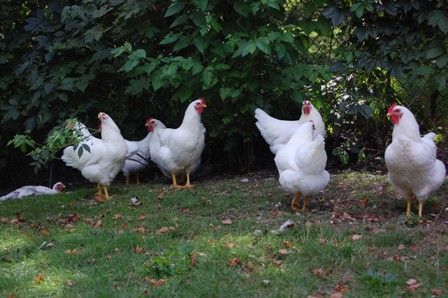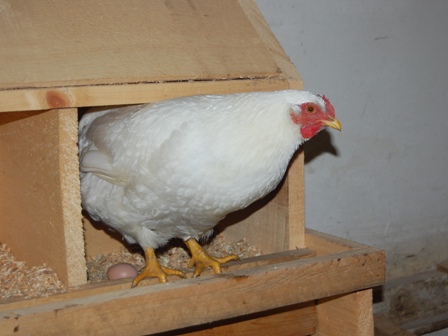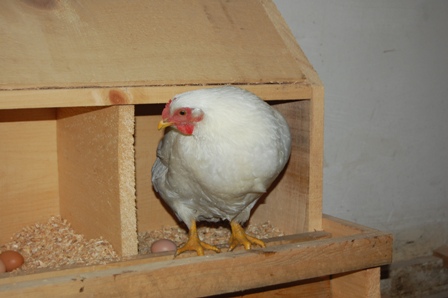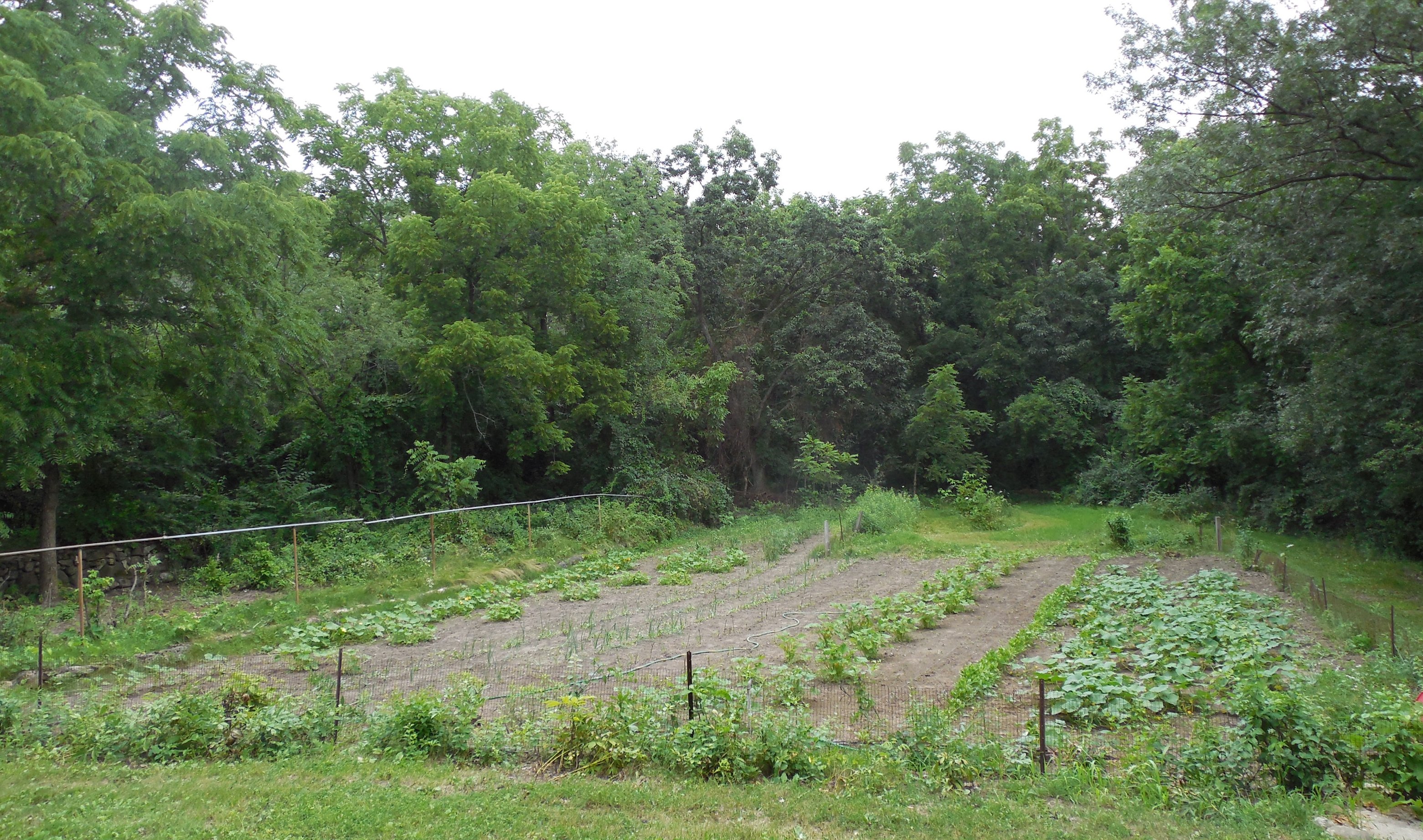A Dutch magazine asked for permission to reprint the lovely photo of a Fayoumi taken by Cyndy Carrol of Syrinx Farm.
Cyndy was agreeable, so permission was granted. The editor said she'd send a link when the article is published, but the magazine looks beautiful.
I don't read Dutch, but anyone can look at these photos and enjoy the birds. The editor, Jan, speaks enough English to communicate with me, so I look forward to having a contact in The Netherlands.
Chickens are so international. They are nearly a cultural universal, something every culture has. I dream of world peace achieved through poultry.
Wednesday, November 27, 2013
Wednesday, November 20, 2013
Pet of the Day
Pet of the Day. Today is Lady Fanny's day in the spotlight!.JPG)
Lady Fanny is a Speckled Sussex, a very old English breed..JPG)
She loves to be a mother, so I get her some fertilized eggs every year and let her hatch them.
Two years ago, it was Coronation Sussex, a beautiful variety developed for the coronation of Edward VIII. He was never crowned, because he abdicated the throne to marry Wallis Simpson, so the variety never got much notice.
This past year she hatched two wild turkey eggs. She enjoyed raising them, but they were soon biger than she is.
Karen invited me to be submit one of my hens as Pet of the Day. Hens can be farm livestock or cherished pets. Consider submitting your chickens and other companion animals to Karen at Pet of the Day.
Thursday, November 14, 2013
Poultry breed purity
D. Philip Sponenberg, DVM, PhD, professor of pathology and genetics at the Virginia-Maryland Regional College of Veterinary Medicine, wrote the following article for The Livestock Conservancy News Summer, 2013 issue. It's available to members but they gave me permission to reprint it here. I've added some photos of foundation poultry breeds -- the Java, the Cochin, Dorking, Chantecler and Polish
“Breeds” – Livestock and Poultry
Breeders of poultry and breeders of mammalian livestock
often are thinking different things when they think “breed.” Exploring these
differences can help to facilitate communication and can also help to advance
effective breed conservation. For this article, “poultry” will mean avian
breeds, and “livestock” will mean mammalian breeds, even though these are hardly
ideal definitions all the way around.
.jpg) | |
| Donnis Hedley's Mottled Java shows what a good mother she is. |
Breeders of both poultry and livestock breeds do agree that
the basic characteristic of breeds is their consistent appearance. That is, one
breed is usually distinguished from another because it has an array of physical
traits that are repeatable and unique to that breed. This uniformity comes down
to the present in different ways, though, and these differences are where
poultry and livestock often differ.
In the minds of most livestock breeders the uniformity of
breeds results from the expected interactions of foundation (what goes into the
original mix), isolation (so the mix is not further jumbled or changed along the
way by outside stock), and selection (which specific animals breeders choose to
keep, and which they choose to reject). In most cases a fourth dimension is
piled on here, which is that the whole result is functioning in a specific
environment, along with people, for the purposes of production.
 |
| Reliable Poultry Publishing Company used these Buff Cochins as an example of the breed in the early 20th century. |
This whole process of breed formation tends to give a final
phenotype (basically, what can be seen or measured) almost as a secondary
result. The cascade of events starts with foundation (what was available), then
isolation (nothing else was available!), and selection (breeders needed the
animals to do this or that) and the result was animals shaped by the interactions
of these three in the environment and serving people. This process results in a
certain degree of uniformity.
The uniformity can then be taken a final step as a more
deliberate process when breeders organize, notice the similarities among their
animals, and then deliberately eliminate some rare variants that do not fit the
majority package of traits. This final step is breed standardization, but in
most cases it was the crowning final event on a process already leading to the
end result of reasonable uniformity.
For many poultry breeds this same process of breed
development has occurred, resulting in breeds that function biologically in
exactly the same way that livestock breeds function. But for poultry, a second
pathway has become nearly as important as this first, and poultry breeders do
not reliably distinguish between these two pathways in either their thinking or
their practices.
 |
| My own White and Colored Rosecomb Dorkings |
Poultry breeders, seeing the almost inadvertent uniformity
brought by the first (livestock) process, have often targeted superficial
phenotypic uniformity without necessarily including the steps of foundation,
isolation, and selection. In many cases poultry breeders have envisioned a final
external phenotype, and then have blended various influences to attain that phenotype.
In many poultry breeds the result has been that varieties within the breeds do
not share histories of foundation, isolation, and selection with one another.
For example, White, Buff, and Partridge Chantecler chickens each come from a
different foundation, even though the final products resemble one another in
all but color. Selection is the key here, with foundation and isolation playing
minor roles if any at all.
 |
| Gina Bisco's White Chantecler |
This second path to breed development leads, in poultry, to
a logical split in what might be called primary breeds as opposed to secondary
breeds. Primary breeds are those that are breeds in the livestock sense, having
a background of foundation, isolation, and selection. Secondary breeds end up
with their uniformity coming from targeted selection for a specific phenotype even
though the foundation and isolation steps are not shared. Each of these types of
breeds has importance, but they are fundamentally different in their function
as biological units.
Many poultry breeders consider the outward phenotypic
uniformity to be all that there is to breeds. In that case, outcrossing to
bring things in is perfectly logical, because the breed is indeed (in their
minds) that final external phenotypic package. This does change the underlying genetic
package of the breed, which is of conservation importance. A good example are
the multitude of Wyandotte varieties, many of which share no common foundation
but which have an array of skin color, comb type, and body shape that is shared
across them all. The superficial similarities are a veneer over very real
underlying differences.
Unfortunately this attitude, and these practices, put at
risk the many poultry breeds that are indeed primary breeds. These genetic
packages must be protected. In these primary breeds, genetic phenomena like
epistasis and linkage are important, and outcrossing can disrupt these.
 |
| Commercial Poultry made the White Crested Black Polish its cover bird in 1910. |
Poultry breeders need to be diligent in understanding the
character of their breeds, and need to reflect on the importance of foundation and
isolation in maintaining the genetic uniqueness of their breeds. Ignoring this,
and resorting to outcrosses, can assure that the result is “such and such” a
breed in name only, with the underlying genetic package based on foundation and
isolation long gone.
Friday, November 8, 2013
Whole Home News
Voyageur Press has a helpful blog with lots of information from its many authors -- of which I am one -- Whole Home News. It's a great way to excerpt bright ideas from many areas.
This week includes my post on the definition of 'heritage chicken.' There are a lot of terms applied to poultry that lack legal definition in the marketplace. As a result, less scrupulous marketers use them to mean almost anything. 'Heritage' is one of those words. 'Organic’ is strictly defined, by the standards of the National Organic Program.
These Buckeyes of Chris McCary's are an APA recognized breed, with a well-known history. They are certainly free range and cage free. Whether they are also organic depends on whether their feed is entirely organically produced and other requirements. 'Natural' is a term that would be applied to them after they are butchered for the table, whether any other ingredients have been added.
This week includes my post on the definition of 'heritage chicken.' There are a lot of terms applied to poultry that lack legal definition in the marketplace. As a result, less scrupulous marketers use them to mean almost anything. 'Heritage' is one of those words. 'Organic’ is strictly defined, by the standards of the National Organic Program.
These Buckeyes of Chris McCary's are an APA recognized breed, with a well-known history. They are certainly free range and cage free. Whether they are also organic depends on whether their feed is entirely organically produced and other requirements. 'Natural' is a term that would be applied to them after they are butchered for the table, whether any other ingredients have been added.
Other terms, such as ‘natural’ and ‘free range,’ are less
precisely defined. Generally, ‘natural’
means that artificial ingredients or coloring have not been added or
injected into the bird at the processing plant. ‘Free range’ or ‘free roaming’
means that the birds have access to the outdoors. ‘Cage-free’ means the birds
are not confined to cages but grouped together in an enclosure. There may be thousands of chickens crowded under a single roof that are technically cage-free.
‘Free range’ chickens
may have access to the outdoors, but it may be bare ground that doesn’t offer
shade or interesting things to scratch for. Chickens may not bother going
outside. Chickens enjoy foraging for part of their diet by
scratching for seeds and bugs.
The best way to know exactly what each of those terms means for the chickens you buy is to know the farmer.
Thanks, Whole Home News, for offering helpful information to your readers.
Wednesday, November 6, 2013
White Rocks at Ten Chimneys
Ten Chimneys in Wisconsin is the estate of Alfred Lunt and Lynne Fontanne. This post from the Newsletter tells about the new White Rock chicken flock they have restored to the estate:
This summer, Alfred and Lynn’s estate has come to life, quite literally, with chickens comfortably settling into Ten Chimneys historic chicken coop and Alfred’s beloved vegetable garden taking root with flourishing produce.
The White Rock chicks we welcomed in March are thriving and beginning to lay eggs. While our flock remains small, the Lunts at one time included over two hundred birds, which they raised for their eggs and meat. Ben Perkins, longtime farm manager on the estate, would have the capons canned and would mail them, along with other farm produce, to Alfred and Lynn while they were away from Genesee Depot.
Alfred and Ben Perkins corresponded weekly, sometimes daily, regarding the activities taking place on the farm. In 1946 Ben wrote to Alfred, “Dear Mr. Lunt, it is a beautiful day in Genesee. The sun is shining and the chickens are singing.” The same rings true today.
Up the hill from the chickens lies Alfred’s vegetable garden. Alfred took great pride in his garden. He once said, “After I finish working in the garden, I’m quite content to sit and stare at it. Crazy, isn’t it? ... I like doing physical things, and I like a clean weedless garden. Then I sit and watch it for hours. I suppose I enjoy it because it’s a kind of showing off, like acting.” Ten Chimneys Foundation has enjoyed rehabilitating the garden and while it’s not grown to its full capacity and ready to “show off” in quite the same way Alfred did, we’re thrilled with the transformation that has begun and the produce that we have grown.
Last week, we donated cucumbers to the House of Peace in Milwaukee. The House of Peace has been serving those in the heart of Milwaukee’s Central City since 1968. For more information, visit: www.houseofpeacemilwaukee.org. Ten Chimneys Foundation will continue to donate produce from Alfred’s garden to organizations in our community.
The new sights, sounds, and smells on the estate allow us all to experience what life might have been like when the Lunts were in residence on this gentleman’s farm. To be a part of our Agricultural Program, please contact Erika Laabs at (262) 968-4161 ext. 204 or elaabs@tenchimneys.org.
(262) 968-4161 ext. 204 or elaabs@tenchimneys.org.




This summer, Alfred and Lynn’s estate has come to life, quite literally, with chickens comfortably settling into Ten Chimneys historic chicken coop and Alfred’s beloved vegetable garden taking root with flourishing produce.
The White Rock chicks we welcomed in March are thriving and beginning to lay eggs. While our flock remains small, the Lunts at one time included over two hundred birds, which they raised for their eggs and meat. Ben Perkins, longtime farm manager on the estate, would have the capons canned and would mail them, along with other farm produce, to Alfred and Lynn while they were away from Genesee Depot.
Alfred and Ben Perkins corresponded weekly, sometimes daily, regarding the activities taking place on the farm. In 1946 Ben wrote to Alfred, “Dear Mr. Lunt, it is a beautiful day in Genesee. The sun is shining and the chickens are singing.” The same rings true today.
Up the hill from the chickens lies Alfred’s vegetable garden. Alfred took great pride in his garden. He once said, “After I finish working in the garden, I’m quite content to sit and stare at it. Crazy, isn’t it? ... I like doing physical things, and I like a clean weedless garden. Then I sit and watch it for hours. I suppose I enjoy it because it’s a kind of showing off, like acting.” Ten Chimneys Foundation has enjoyed rehabilitating the garden and while it’s not grown to its full capacity and ready to “show off” in quite the same way Alfred did, we’re thrilled with the transformation that has begun and the produce that we have grown.
Last week, we donated cucumbers to the House of Peace in Milwaukee. The House of Peace has been serving those in the heart of Milwaukee’s Central City since 1968. For more information, visit: www.houseofpeacemilwaukee.org. Ten Chimneys Foundation will continue to donate produce from Alfred’s garden to organizations in our community.
The new sights, sounds, and smells on the estate allow us all to experience what life might have been like when the Lunts were in residence on this gentleman’s farm. To be a part of our Agricultural Program, please contact Erika Laabs at
 (262) 968-4161 ext. 204 or elaabs@tenchimneys.org.
(262) 968-4161 ext. 204 or elaabs@tenchimneys.org.



Subscribe to:
Posts (Atom)
.jpg)

.JPG)



